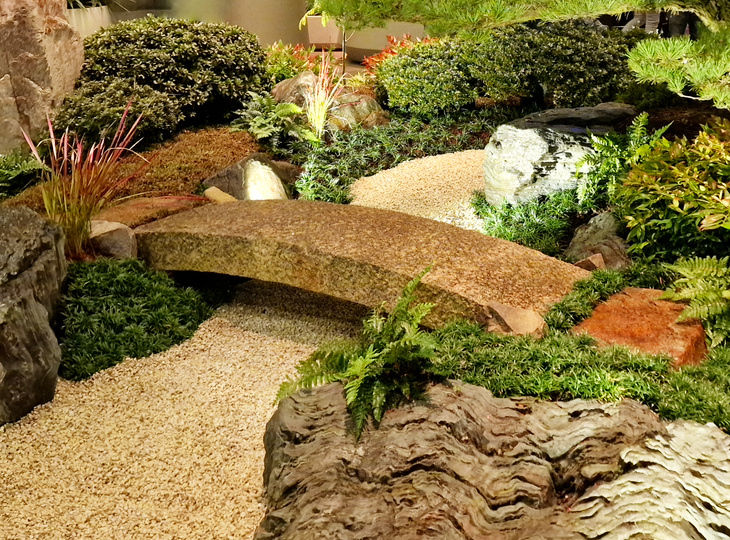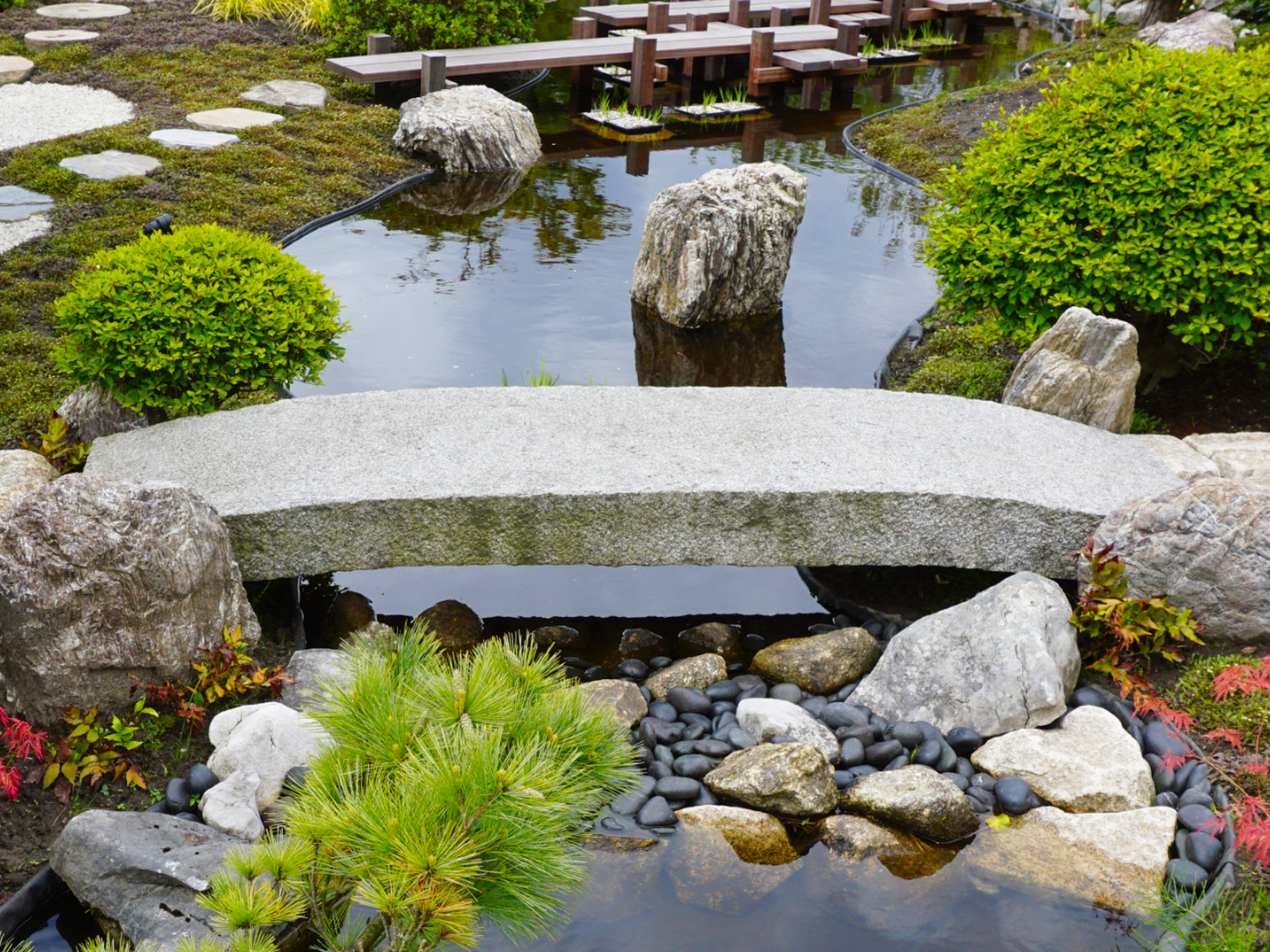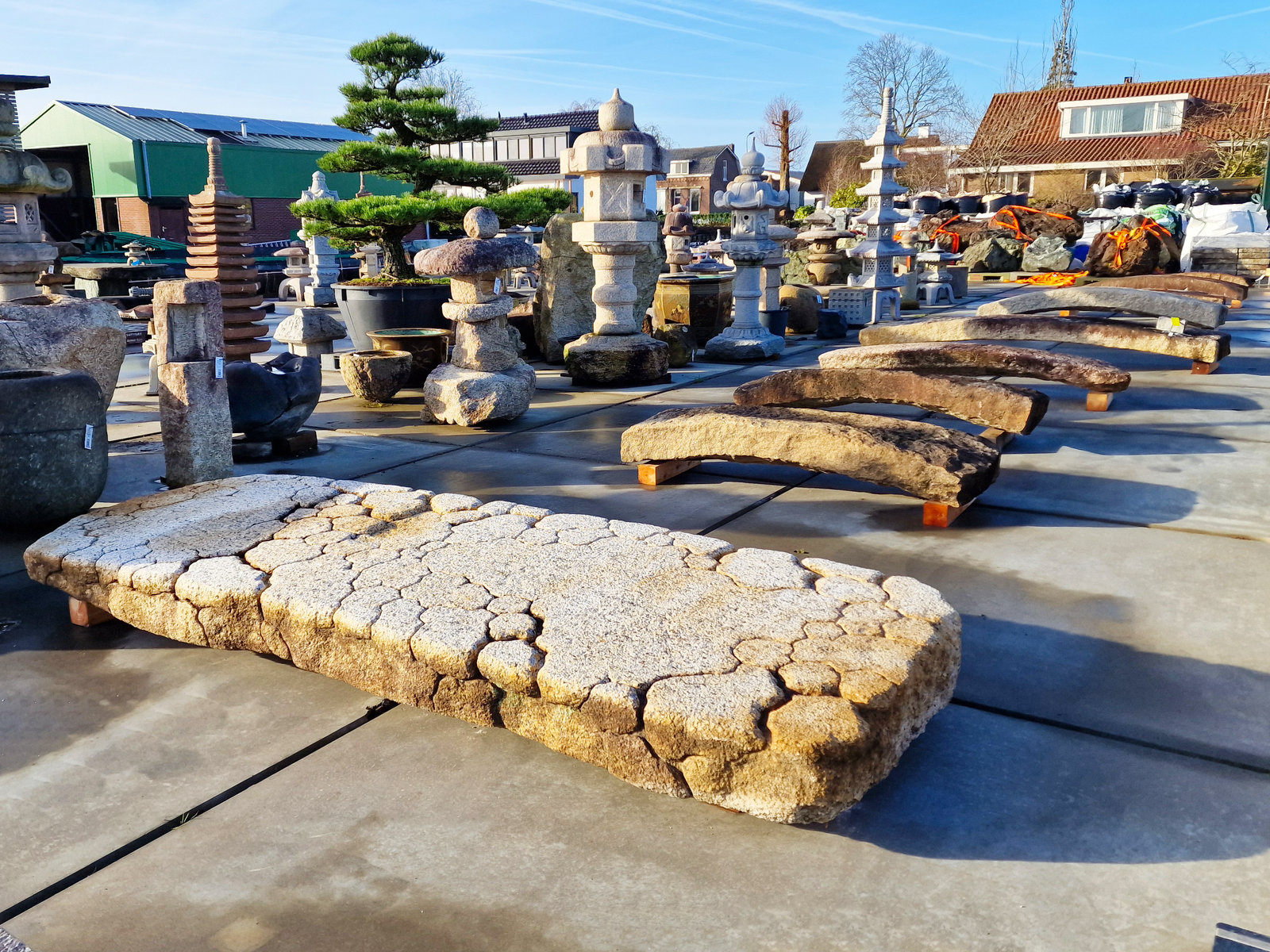Japanese Stone Garden Bridges - Information

Traditional Japanese Stone Garden Bridges: A Timeless Element of Elegance and Symbolism. Bridges in Japanese gardens are far more than practical structures, they are poetic expressions of transition, transformation, and timeless beauty. Among these, the traditional Japanese stone garden bridge, or ishibashi (石橋), holds a special place in the history and art of Japanese landscape design. These enduring features link more than just one garden path to another, they connect the physical with the symbolic, the earthly with the spiritual, and the present moment with the eternal.
At Yokoso Japanese Gardens, we are proud to offer a curated and exclusive collection of authentic Japanese stone garden bridges, sourced from Japan and selected for their historical authenticity, craftsmanship, and natural harmony with traditional garden design principles.
Origins and Symbolism
The use of bridges in Japanese gardens can be traced back to the Heian period (794–1185), a time when aristocratic gardens modeled after the Pure Land Buddhist paradise incorporated water features and islands symbolizing sacred realms. Stone bridges, as opposed to wood, gained popularity during the Muromachi period (14th–16th century) with the rise of Zen influence, which emphasized permanence, simplicity, and harmony with nature. In a symbolic sense, a bridge (hashi) represents a transition or passage, between this world and the next, ignorance and enlightenment, or chaos and order. Walking across a bridge is a contemplative act, inviting the visitor to leave behind distraction and move toward serenity.
Types of Traditional Japanese Stone Garden Bridges
Traditional Japanese stone bridges vary in form, size, and application. Each type is chosen carefully based on the surrounding landscape, intended symbolism, and aesthetic composition of the garden.
Flat Stone Bridge (Heibanbashi / Hirabashi) - A simple, flat slab of stone spanning a narrow stream or dry riverbed. This is one of the most common and humble styles, typically used in Zen gardens or modest residential settings. Symbolism: Calmness and subtlety; a bridge meant not to dominate but to blend in with its environment. Ideal for: Dry gardens (karesansui) or tea gardens (roji).
Arched Stone Bridge (Soribashi) - Carved with a gentle or pronounced arch, this bridge represents the more dynamic and architectural style of the Edo period. It is often found in stroll gardens (kaiyū-shiki teien), designed to provide changing views with every step. - Symbolism: The passage over life's challenges or transitions into higher spiritual awareness. - Ideal for: Pond crossings, visual focal points.
Multi-Stone Bridge (Yatsuhashi) - Composed of several flat stones laid in a zigzag or staggered pattern, often over shallow water or a marshy area. Inspired by classical poetry and the aesthetics of impermanence. - Symbolism: Imperfection and natural movement, evoking the poetic image of crossing through iris flowers (kakitsubata). - Ideal for: Tea gardens, poetic or literary-themed landscapes.
Stepping Stone Bridges (Tobi-ishi) - A series of stones laid closely together over water or dry streambeds, often giving the feeling of walking across nature itself. While not always considered bridges in the Western sense, they function as such in Japanese design. - Symbolism: Mindful movement, harmony with the natural rhythm of life. - Ideal for: Intimate gardens, pathways near chōzubachi or tsukubai.
Placement in the Garden According to the Sakuteiki
The Sakuteiki (作庭記), Japan's oldest garden manual written in the 11th century, provides guidance on the thoughtful and spiritual placement of all garden elements, including bridges. According to its principles, every component must be integrated with deep awareness of nature's rhythm, topography, and spiritual resonance. Key Guidelines from the Sakuteiki:
Respect for Natural Flow - Bridges must never feel forced or artificial. The placement should follow the natural terrain, water flow, or dry stream paths. They should seem as though they have always been there, emerging organically from the landscape.
Orientation and Balance - A stone bridge must be oriented to guide movement with intention. In many cases, the bridge connects two meaningful zones of the garden, such as a spiritual shrine area and a place of contemplation or a tea house and its approach path.
Emphasis on Harmony, Not Dominance - Even grand arched bridges should feel like a natural part of the environment rather than a dominating structure. The stone's aging, patina, and moss growth should complement surrounding rocks, plants, and water features.
Mindful Crossing - The act of crossing a bridge should slow the guest down, creating a moment of pause, transition, or reflection. Stepping stones and irregularly shaped surfaces encourage careful, deliberate movement.
Integration with Other Elements - Stone bridges are rarely isolated. They are part of a larger choreography involving lanterns, trees, rocks, and water. Their presence helps shape the experience of the garden and invites reflection from multiple angles and perspectives.
Materials Used in Traditional Japanese Stone Garden Bridges
Traditional Japanese stone bridges are crafted from natural stones chosen for their durability, aesthetic texture, and ability to harmonize with the environment over time. Each stone bridge is either hand-carved from a single slab or assembled from multiple stones, depending on the desired visual effect and structural requirement. The aging process is welcomed, moss, watermarks, and natural erosion add to their spiritual and aesthetic charm. Most Common Materials:
Granite (Ishi) - The most durable and frequently used stone, available in both rough-hewn and polished finishes. Its natural speckling and weathering over time create a dignified and ancient feel.
Basalt - Dark and subtly textured, basalt bridges have a heavier presence and are often used in temple gardens or larger landscapes.
Andesite and Tuff - Lighter and easier to carve, these stones are ideal for decorative or smaller-scale bridges, especially those in poetic tea gardens.
Antique Reclaimed Stone - At Yokoso Japanese Gardens, we offer reclaimed stone bridges from historic Japanese estates and temples. These pieces carry a unique sense of age and cultural memory.
Exclusively Available at Yokoso Japanese Gardens
Yokoso Japanese Gardens is proud to present an exclusive selection of authentic Japanese stone garden bridges, handpicked from artisan workshops and historic Japanese gardens. Our collection includes:
Flat and arched granite bridges
Antique reclaimed bridges from temple sites
Custom-designed stone bridge sets
Multi-stone poetic bridge arrangements
Consultation services for garden integration
Every piece is a work of art, blending cultural history with master craftsmanship. Whether you're designing a traditional Zen retreat or integrating Japanese elements into a modern landscape, our stone bridges offer the authenticity and harmony your project deserves. As one of the few specialized providers of Japanese stonework in Europe, our bridges are exclusively available through Yokoso Japanese Gardens.
Conclusion
Traditional Japanese stone garden bridges are powerful elements of aesthetic and symbolic significance. Whether quietly spanning a dry stream or boldly arching over a reflective pond, they serve as both literal and metaphorical connections, uniting the garden, the visitor, and the spirit of place.
Rooted in centuries of design wisdom, from the Sakuteiki to modern interpretations, these bridges invite slow movement, deep reflection, and appreciation for the beauty of nature's impermanence. With an unmatched collection of authentic, hand-selected stone bridges, Yokoso Japanese Gardens is honored to help you bring a piece of Japanese tradition into your own sanctuary.
#StoneBridge #Ishibashi #ZenGarden #GardenDesign #WabiSabi #GardenBridge #Sakuteiki #Yatsuhashi #GardenArchitecture #LandscapeDesign #AuthenticJapan #AntiqueStone #GardenPathway #JapaneseHeritage #HandcraftedStone














Contact Yokoso Japanese Gardens